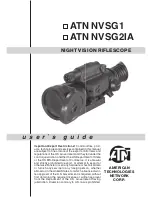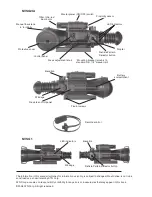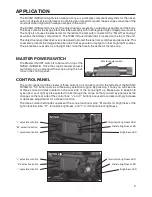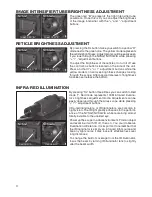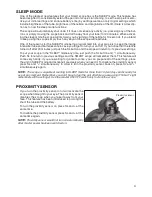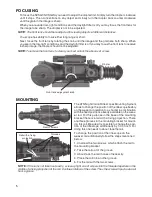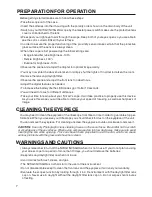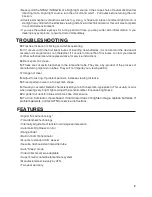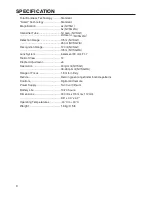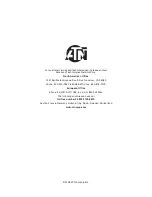
7
PREPARATION FOR OPERATION
Before getting started make sure to follow these steps:
• Take the scope out of the case.
• Insert the batteries into their housing with the polarity order shown on the main body of the unit.
• Switch on your NVSG1/NVSG2IA scope by the master power switch make sure the protective lens
cover is still attached to the lens.
• We expect your right eye to aim through the scope. Keep both of your eyes open so you are able to
see the color-coded LEDs with your left eye.
• In order to assure the proper functioning of the proximity sensor make certain that the protective
glass surface of the sensor is always clean.
• When the scope is first powered up the initial settings are:
- Image intensifier tube brightness -100%
- Reticle brightness -100%
- Illuminator brightness -100%.
• Observe the scene and adjust the diopter for optimal image clarity.
• You may now enter the dark environment or simply shut the lights off in order to darken the room.
• Remove the lens cap/daylight filter.
• Observe the scene and adjust the front lens for ideal focus.
• Adjust the digital features as needed.
• To increase the battery life the LED diodes go off after 10 seconds.
• You will need to focus for different distances.
• Take your time to learn about your “Smart” scope. It will take practice to properly use this device.
As you use this scope you will be able to improve your speed of focusing, as well as sharpness of
image.
CLEANING THE EYEPIECE
You may need to clean the eyepiece of the riflescope from time to time in order to guarantee top per-
formance. When you receive your riflescope you should check for dust on the eyepiece of the unit.
You can remove the eyepiece. For cleaning unscrew the eyepiece counter-clockwise to remove it.
CAUTION:
Use only Photographic lens cleaning tissue on these surfaces. Be careful not to scratch
or smudge any of these surfaces. When using compressed air to blow dust away, make sure to avoid
inverting the can while spraying. This can cause frozen propellant to exit the can, which can cause
serious problems with the glass and phosphor screen.
WARNINGS AND CAUTIONS
• Always remember to turn off the NVSG1/NVSG2IA when it is not in use. If you do not plan on using
your aries scope for a period of more than 10 days, you should remove the batteries.
• Keep lens cap/daylight filter on when not in use.
• Avoid contact with dust, steam, and gas.
• The NVSG1/NVSG2IA is not harmful to the user or the environment.
• Do not disassemble except to clean the front lens and the eyepiece: it will void your warranty.
• Evaluate the scopes function by looking through it in a lit environment with the daylight filter lens
cap on. Never use in daylight without the daylight filter lens cap on. Do not surpass ten minutes
of testing.

